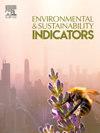Evolution and drivers of green total factor productivity network structure in the Yangtze River economic belt from the perspective of urban agglomerations
IF 5.4
Q1 ENVIRONMENTAL SCIENCES
引用次数: 0
Abstract
Enhancing inter-city Green Total Factor Productivity (GTFP) connections is crucial for achieving high-quality development across the Yangtze River Economic Belt (YREB). This study constructs a spatial correlation network of GTFP for this region, analyzing its characteristics within the YREB and its three major urban agglomerations from 2005 to 2020 using social network analysis. QAP analysis is applied to explore the drivers of GTFP linkages between cities. Results reveal that (1) GTFP connectivity within the YREB strengthened continuously during the study period. The spatial correlation network density of GTFP in the YREB, Yangtze River Delta city cluster, middle reaches of Yangtze River City cluster and Chengdu-Chongqing City cluster showed a development trend of “rise-decline-rise," “rise-decline," “decline-rise," and “decline-rise-decline," respectively, and the network density always showed a “downstream > midstream > upstream" and"central city > non-central city.” (2) GTFP network's center shifted from Wenzhou to Suzhou, then to Changsha, and finally to Shanghai, with a growing multi-centrality trend in the Yangtze River Delta, dominant roles for Changsha and Wuhan in the middle reaches, and consistent leadership by Chengdu in the Chengdu-Chongqing agglomeration. (3) QAP analysis identifies urban agglomeration construction, industrial development, technological innovation, and environmental regulation as key drivers of GTFP spatial linkages, with urban agglomeration construction having the greatest impact. To advance GTFP and foster coordinated development in the YREB, this study recommends that central cities lead through strategic guidance and incentives for less developed areas, supporting agglomeration construction, technological innovation, and environmental protection as pathways to sustainable, high-quality growth.
城市群视角下长江经济带绿色全要素生产率网络结构演化及驱动因素
加强城市间绿色全要素生产率(GTFP)对接对实现长江经济带高质量发展至关重要。本文构建了长江经济带及其三大城市群2005 - 2020年GTFP的空间关联网络,运用社会网络分析了GTFP在长江经济带及其三大城市群内的特征。应用QAP分析探讨城市间GTFP联系的驱动因素。结果表明:(1)研究期间,长江经济带内GTFP连通性不断增强。长江经济带、长三角城市群、长江中游城市群和成渝城市群的GTFP空间相关网络密度分别呈现“上升-下降-上升”、“上升-下降”、“下降-上升-下降”和“下降-上升-下降”的发展趋势,且网络密度始终呈现“下游-上升-下降”的趋势;中游的在“上游”和“中心城市”;中心城市。②GTFP网络中心由温州向苏州、长沙、上海转移,长三角多中心化趋势增强,中游以长沙、武汉为主导,成渝城市群以成都为主导。(3) QAP分析发现,城市群建设、产业发展、技术创新和环境规制是GTFP空间联系的关键驱动因素,其中城市群建设的影响最大。为促进长江经济带的GTFP和协调发展,本研究建议中心城市通过对欠发达地区的战略引导和激励,支持集聚建设、技术创新和环境保护,从而实现可持续、高质量的增长。
本文章由计算机程序翻译,如有差异,请以英文原文为准。
求助全文
约1分钟内获得全文
求助全文
来源期刊

Environmental and Sustainability Indicators
Environmental Science-Environmental Science (miscellaneous)
CiteScore
7.80
自引率
2.30%
发文量
49
审稿时长
57 days
 求助内容:
求助内容: 应助结果提醒方式:
应助结果提醒方式:


